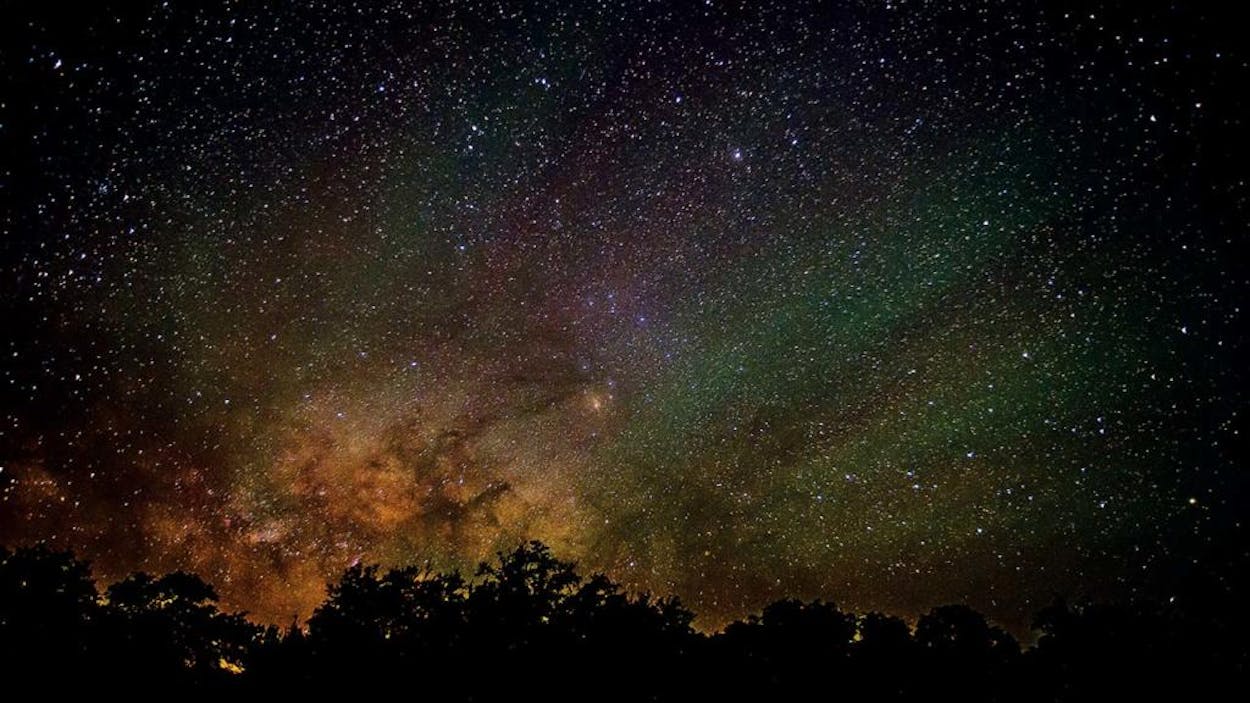When the setting sun dips below the hills surrounding South Llano River State Park, it leaves behind a fiery orange sky. As orange fades to yellow, then blue, then gray, the stars emerge: first a few bold points of light, then a wash of white speckles stretching from horizon to horizon. Below, darkness flattens the mesquite trees into shadow puppets silhouetted against the sky. Among the trees, nothing is visible. Your own hand, inches from your face, is a vague apparition.
The depth of this darkness was recognized in February when the park, near Junction, was named a gold-tier International Dark Sky Park by the International Dark-Sky Association, or IDA, which advocates for protecting night skies from light pollution. On the Bortle scale, a measure of darkness ranging from a pitch-black 1 to a city-sky 9, the park rates a 3. It earned the designation after a yearlong application process that included retrofitting light fixtures, installing a sky-quality meter, and committing to educate the public through night hikes and star parties.
Park interpreter Holly Platz coordinates those events with the help and the telescopes of Texas Tech University’s Outdoor School, in Junction, and the Mason Star Gazers, an astronomy club headquartered an hour away. But here, telescopes aren’t necessary to see the stars. On a clear February night, when the waning crescent moon won’t rise until the wee hours, she points out half a dozen constellations visible to the naked eye. Here is the star-studded belt of Orion, the mythical hunter, flanked by his loyal dog, Canis Major. Nearby are the Pleiades, a tiny dipper-shaped cluster of stars also known as the Seven Sisters. Lower in the sky, five stars in a crooked line show the vain queen Cassiopeia seated on her throne. The planet Venus, masquerading as a brilliant star, outshines them all.
Later in the year, star-party guests will see other constellations as the Earth’s tilt brings a different set of characters into view. “We see Orion in the winter and Cassiopeia year-round, and the swan and scorpion in the summer,” Platz says. “To me, it’s similar to how the birds change with the seasons: Here come the painted buntings in the spring. Here come the goldfinches in the fall.”
But as Texas becomes urbanized, many people never see the stars at all. A satellite map of light pollution in the United States shows the country split down the middle, with nearly everything to the east full of light and broad swaths of the west still dark. The Interstate 35 corridor forms the boundary between the two; immediately west is the Hill Country. “We call it ‘the edge of night,’ because you have dark skies that are close to very populated cities,” says IDA board member Ken Kattner, a Houston lawyer and amateur astronomer who is leading an effort to curb light pollution in the area. “If we don’t do something now, we’re going to lose that forever.”
Dark-sky enthusiasts in Texas have been galvanized by that threat. Of the 44 dark-sky parks around the world, 5 are in Texas. The towns of Dripping Springs and Horseshoe Bay are 2 of the 14 certified Dark Sky Communities worldwide. Several other municipalities, including Fredericksburg and Llano, have passed dark-sky ordinances that govern outdoor lighting.
Astronomers aren’t alone in their preference for dark skies. Artificial light, in widespread use in the U.S. only since the thirties, disrupts animals’ circadian rhythms. Sky glow over cities confuses migratory birds, which rely on the stars and moon for navigation. The IDA even suggests that humans’ sense of wonder is endangered when dark skies disappear.
“You think about not only the stars and planets and moon and galaxy; you ponder a lot of other things about life when you’re under the stars,” says Chuck Nance, a San Antonio resident who has brought his telescope, a 130-pound Dobsonian reflector, to South Llano this February night. “I think about God a lot—not that I’m religious, but I marvel at the physical world. The other thing is, Are we alone? You think about how many stars there are just in our galaxy, and how many of those stars have planets like Earth, and it makes you wonder.”
In a parking lot near the campground, Nance trains his telescope on the Orion nebula, a cloud of gas and dust more than a thousand light-years away. “I’ve never seen it look so magnificent,” he says, peering into the eyepiece. “It looks like it’s 3-D.”
Hours later, as the moon rises and the dew creeps in, Nance steps away from his telescope. His head tilted back, he turns slowly in a circle to take in the immense sky. The Earth’s rotation has pushed Orion westward, following the Seven Sisters toward the horizon. Suddenly, a ball of yellow light appears in the northern sky and blazes downward for a few slow seconds. One breath later, the shooting star is gone.







